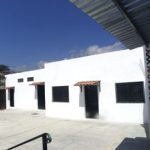
The practice of midwifery in Mexico goes back to the pre-Hispanic cultures of the people living in Mexico before the arrival of the conquistadors in the early 16th Century. In the early days of the country, midwives were the only option available for care during pregnancy and childbirth as state health service was too far away, as it is for some today.
Revisiting the emergence of midwifery in modern home birthing here in the villages of Lakeside, after a decade of being maligned by local medical institutes, they arise again, welcomed and supported when the pandemic put mothers into the impossible situation of having no local clinic or hospital to go to. Government recognition came quickly.
Theresa Braine wrote an article regarding the awakening of the local governments to the needs of pregnant women, and the necessity for doctors, nurses and midwives to work together to keep the modern methods of using stirrups and caesareans to a minimum, going back to natural home birthing that those mothers of higher socioeconomic society can enjoy even in a hospital setting. Local indigenous midwives have been using this method for years, but it was shunned as primitive and the government did its best to outlaw midwifery.
Centro para los Adolescentes de San Miguel Allende (C.A.S.A,) opened in 1997, a training school for midwifery and many other social interventions for violence against women, and all aspects of sexual and reproductive health. In a three-year course they are trained in reproductive health care through evidence based on medical knowledge. Twenty-four CASA midwife graduates are working in hospitals in the public sectors of Chihuahua, San Luis Potosi, Tabasco, Guerrero, Colima, Puebla and Vera Cruz. A little drop in the bucket but a huge beginning for a noble calling.
Another is Escuela de Parteras Profesionales de Guerrero, a state school. Both schools practice intervention in crimes against women as well as the art of modern midwifery. Midwifery does require licensing, usually for hospital workers, but the law has always looked the other way for the indigenous and rural women for whom reaching out to professionals is impossible and their only recourse is the self-trained village “parteras,” whose work, although based on the old midwifery practiced before them, is very effective and could be more so with training in the modern methods, which are almost the same. Rather than the modern stirrups, beds and the harmful caesarean, the mother is allowed any position in which she feels comfortable, standing, squatting, sitting or in a tub filled with water.
We are looking at the professional midwife verses the traditional. The professional is licensed and the traditional by law must be eighteen and have a secondary education or more. The attempted professionalization of midwifery is mixing traditional knowledge with medical approaches, which is what the Tepehua Medical Center will be aiming for by giving the Modern Methods Midwifery classes for natural birthing at the Tepehua Community Center to all local midwives who apply. Their reward will be a kit briefcase for all the tools they may require and backup by doctors and nurses should they need it. The success of this program depends on how many midwives come forward for the retraining. The sign-up for it will close in November.
Having spoken to the women of Tepehua who have had the experience of both birthing at home and the hospital, some say the care is so much more personal at home and they heal faster. But others say the professional impersonal treatment of the hospital is better away from family chaos. Either way it is having a choice that counts, and for those with no choice but to birth at home, the midwife is a blessing.
- Profiling Tepehua – January 2024 - December 26, 2023
- Profiling Tepehua – December 2023 - November 30, 2023
- Profiling Tepehua – November 2023 - October 31, 2023









